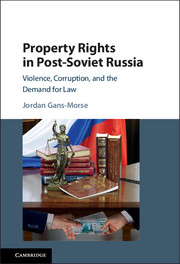Book contents
- Frontmatter
- Contents
- List of Tables
- List of Figures
- Acknowledgments
- 1 Violence, Corruption, and Demand for Law
- 2 Institutional Supply and Demand
- 3 The Evolution of FirmStrategies
- 4 The Role of State Legal Capacity
- 5 Demand-Side Barriers to the Use of Legal Strategies
- 6 The Effectiveness of Illegal Strategies
- 7 Variation in Strategies across Firms
- 8 Firms, States, and the Rule of Law in Comparative Perspective
- Appendices
- References
- Index
3 - The Evolution of FirmStrategies
Published online by Cambridge University Press: 13 July 2017
- Frontmatter
- Contents
- List of Tables
- List of Figures
- Acknowledgments
- 1 Violence, Corruption, and Demand for Law
- 2 Institutional Supply and Demand
- 3 The Evolution of FirmStrategies
- 4 The Role of State Legal Capacity
- 5 Demand-Side Barriers to the Use of Legal Strategies
- 6 The Effectiveness of Illegal Strategies
- 7 Variation in Strategies across Firms
- 8 Firms, States, and the Rule of Law in Comparative Perspective
- Appendices
- References
- Index
Summary
The Soviet Union's collapse at the end of 1991 initiated a grim period for Russia, with GDP falling approximately 23 percent over the next two years and the annualized inflation rate topping 800 percent in 1993.With respect to property security, Russia resembled few places on earth. During 1993, 61 bombs exploded in Moscow as criminal groups battled for territorial control. In just the first half of 1994, 52 bombs shook the Russian capital (Hoffman, 2002, p. 277). The Ministry of Internal Affairs (MVD) officially catalogued 562 contract killings in 1994, nearly double the official number from the year before, and, naturally, this official figure represented only a fraction of the total (Statkus, 1998, p. 66). Use of the commercial court system, created on the foundations of Soviet institutions in 1992, continued to fall, with firms initiating only about 200,000 cases in 1994 (VAS, 2011). Meanwhile, organized crime crept into nearly all sectors of the economy, extorting firms on the one hand while offering property protection and contract enforcement services on the other (Webster, 1997, p. 2).
Yet by the mid-2000s, a foreign businessperson who had suffered the misfortune of visiting Russia in the early 1990s would not recognize the country that had emerged. The economy was booming, with GDP growing at more than 7 percent in both 2003 and 2004. Inflation was at a manageable 11 percent. If the foreign businessperson were to inquire of Russian business partners about the dangers of mafia rackets, she would have received the same response I did when querying respondents in interviews throughout 2009: a confused and slightly scornful smile, as if to say, “Mafia, please – that was so 1990s!” Amore knowledgable foreigner might have possessed the wherewithal to ask business partners about their informal connections with local bureaucrats or law enforcement, who by the mid-to-late 1990s had begun to fulfill the functions of criminal protection rackets. Yet even this inquiry might have elicited disconcerted looks from business partners, many of whom already had come to rely primarily on lawyers and courts. In fact, by the mid-2000s, around twothirds of larger firms and one-third of smaller firms had sued or been sued (Rimskii, 2009, Table 2.1), and firms’ use of the commercial court system had more than doubled since the early 1990s – and was about to double again by 2010 (VAS, 2011).
- Type
- Chapter
- Information
- Property Rights in Post-Soviet RussiaViolence, Corruption, and the Demand for Law, pp. 43 - 70Publisher: Cambridge University PressPrint publication year: 2017

